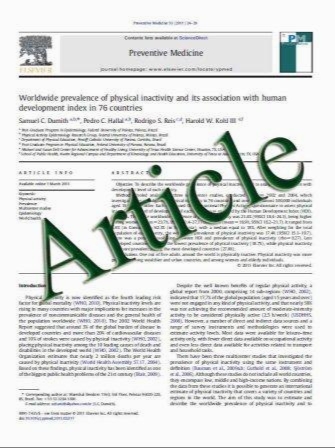Chronic nonspherocytic hemolytic anemia due to glucose-6-phosphate dehydrogenase deficiency: report of two families with novel mutations causing G6PD Bangkok and G6PD Bangkok Noi
- نوع فایل : کتاب
- زبان : انگلیسی
- مؤلف : Voravarn S. Tanphaichitr & Akira Hirono & Parichat Pung-amritt & Ajjima Treesucon & Wanchai Wanachiwanawin
- چاپ و سال / کشور: 2011
Description
Glucose-6-phosphate dehydrogenase (G6PD) deficiency is one of the most common hereditary enzymopathies worldwide. Mostly G6PD deficient cases are asymptomatic though they may have the risk of neonatal jaundice (NNJ) and acute intravascular hemolysis during oxidative stress. Chronic nonspherocytic hemolytic anemia (CNSHA) due to G6PD deficiency is rare. In Thailand, one case was reported 40 years ago and by biochemical study this G6PD was reported to be a new variant G6PD Bangkok. We, herein, report two families with CNSHA due to G6PD deficiency. In the first family, we have been following up the clinical course of the patient with G6PD Bangkok. In addition to chronic hemolysis, he had three acute hemolytic episodes requiring blood transfusions during childhood period. Multiple gallstones were detected at the age of 27. His two daughters who inherited G6PD Bangkok from him and G6PD Vanua Lava from his wife are asymptomatic. Both of them had NNJ and persistent evidences of compensated hemolysis. Molecular analysis revealed a novel missense mutation 825 G→C predicting 275 Lys→Asn causing G6PD Bangkok. In the second family, two male siblings are affected. They had NNJ and several hemolytic episodes which required blood transfusions. On follow-up they have been diagnosed with chronic hemolysis as evidenced by reticulocytosis and indirect hyperbilirubinemia. Molecular analysis revealed combined missense mutations in exons 12 and 13. The first mutation was 1376 G→T predicting 459 Arg→Leu (known as G6PD Canton) and the second one was 1502 T→G predicting 501 Phe→Cys. We designated the resulting novel G6PD variant, G6PD Bangkok Noi.
Ann Hematol (2011) 90:769–775 DOI 10.1007/s00277-010-1153-4 Received: 1 July 2010 / Accepted: 28 December 2010 / Published online: 8 February 2011


